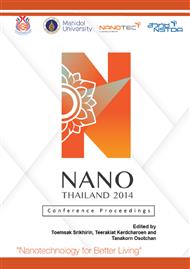p.186
p.193
p.198
p.203
p.210
p.215
p.223
p.227
p.231
Studies on Copper Ion Adsorption Using Pectin/Functionalized-Silica Coated Cellulose
Abstract:
The pectin/functionalized silica coated filter paper (FILPSL2) was used for copper ion adsorption. Silica sol (1), prepared by mixing ethanol, water, TEOS and hydrochloric acid, was slowly added into pectin solution. A piece of filter paper (2 cm x 2 cm) was immersed in the silica-pectin solution for 1 hr. The coated filter paper was dried at room temperature and then oven-dried at 50 °C for 6 hrs to obtain FILPS. The silica sol (2) was subsequently prepared by mixing ethanol, water, N-[3-(Trimethoxysilyl) propyl] ethylenediamine (L2) and hydrochloric acid. The FILPS was immersed in silica sol (2) and the coated paper was oven-dried at 50 °C for 6 hrs to obtain FILPSL2. The SEM micrograph of uncoated Filter paper (FIL) and FILPSL2 showsa characteristic woven pattern. For copper ion adsorption, FILPSL2 was put into 0.1 M of CuCl2solution (pH 2, 25 °C). The color of the paper changes from off-white to intense blue within 5 min due to the complex between amino group of functionalized silica and Cu2+ as evidenced from IR spectroscopy.The equilibrium adsorption percentage and adsorption capacity were 27.10 and 5.5 x 10-3 respectively. The concentrations of copper ion solutions were varied to 10-2and 10-3M at this pH. The lower concentration of copper ion results in the higher adsorption percentage. While the lower concentration of copper ion results in the lower adsorption capacity. The adsorption was also experimented at pH 3.The similar trend was obtained. The optimum pH for adsorption for all concentrations was 2. The effect of interferences on the copper ion adsorption depends on the pH. At pH 2, Ni2+ has a stronger effect. While Cd2+ has a stronger effect at pH 3. The desorption was performed using 0.2 M CH3COOH solution. The complete desorption occurred within 30 min.
Info:
Periodical:
Pages:
210-214
Citation:
Online since:
December 2015
Authors:
Price:
Сopyright:
© 2016 Trans Tech Publications Ltd. All Rights Reserved
Share:
Citation:


